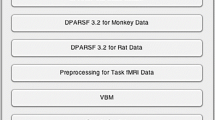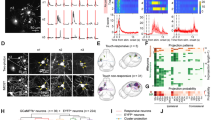Abstract
Brains of workers and males of the ant species Lasius fuliginosus were Feulgen stained. The amount of Feulgen dye of diploid nuclei of the “Perikaryenschicht” were measured microspectrophotometrically. When the slides were kept in the dark at 4° C the colour intensity did not decrease during half a year. Hydrolysis in Schiffs reagent with 0,09 N HCl did not influence the colour significantly. When the same method was used the results were more or less reproducible; 6 of 8 series gave identical values. — Feulgen dye and nuclear volume of diploid cells of ants from a natural habitat decrease from spring to autumn by ca 30 % and 10% respectively. — Ants which were kept in the laboratory for nearly two years did not show such a regular change in the Feulgen dye in their brain cells. These nuclei never reached the colour intensity of those ants from a natural habitat. — No difference in the Feulgen intensity has been found between ants kept in 4° C and at room temperature, respectively. The staining maximum was reached after 1 h by animals from the natural habitat, after 2 h by those from the laboratory. As expected the amount of Feulgen dye of haploid male cells was half of that of diploid worker cells, but the nuclear volume of haploid male cells was larger than half of that of worker cells (Zusammenfassung see p. 93).
Zusammenfassung
-
1.
Diploide Gehirnzellen der Perikaryenschicht von adulten Arbeiterinnen der Ameisenart Lasius (Dendrolasius) fuliginosus wurden mit Feulgen gefärbt. Die Haltbarkeit der Präparate wurde geprüft. Die Extinktionswerte blieben über mindestens ein halbes Jahr konstant, wenn die Präparate im Dunkeln bei 4° C aufbewahrt wurden. Die milde Hydrolyse im Schiffsehen Reagens beeinflußte die Extinktion nicht. Wenn die gleiche Methode auf das gleiche Material angewendet wird, lassen sich mit wenigen Ausnahmen die Ergebnisse reproduzieren.
-
2.
Feulgenwerte und Kernvolumina diploider Kerne von Freilandtieren nahmen vom Frühjahr bis zum Herbst um 30 bzw. 10% ab.
-
3.
Bei Tieren einer Kolonie, die 20 Monate lang im Labor gehalten wurden, zeigte sich zwar eine Schwankung der Extinktionen, aber kein jahreszeitlich bedingter signifikanter Anstieg oder Abfall. Die durchschnittliche Extinktion entspricht der tiefsten Extinktion der Freüandtiere. Nach dem Umsiedeln eines Nestes im Mai ins Labor nahmen die Kernvolumina bis im August ab. Die Werte entsprachen denen der Freilandtiere. An später hergestellten Präparaten ließ sich keine solche Tendenz mehr feststellen. M. laevinodis zeigte ebenfalls bei Labortieren nur 60% des Extinktionswertes der Freilandtiere.
-
4.
Eine Kältebehandlung von 3 Monaten bei 4° C veränderte den Feulgenwert nicht.
-
5.
Die höchsten Feulgenwerte stellten sich bei Labortieren erst nach mindestens 2 Std Färbedauer ein, während bei Freilandtieren das Maximum schon nach einer Stunde erreicht war.
-
6.
Die Extinktionswerte der haploiden Kerne im Männchengehirn betrugen erwartungsgemäß etwa die Hälfte der Werte der diploiden Arbeiterinnenkerne. Das Kernvolumen betrug jedoch 60% der größten Arbeiterinnenkerne, also mehr als die Hälfte der Arbeiterinnenkerne
Similar content being viewed by others
Literatur
Behringer, A.: Quantitative DNS-Messungen an Ameisenhirnzellen. Diplomarbeit Zool. Mus. d. Univ. Zürich 1968.
Boivin, A., Vendrely, R. V., Vendrely, C.: L'acide désoxyribonucléique du noyau cellulaire, dépositaire des caractères héréditaires. C. R. Acad. Sci. (Paris) 226, 1061–1063 (1948).
Brachet, J., Hulin, N., Guermant, J.: Acid lability of deoxyribonucleic acids and cell differentiation. Exp. Cell Res. 51, 509–519 (1968).
Brañez, E., Roels, H.: Variations in the nuclear deoxyribonucleic acid content in the adrenal cortex of the female white rat during the oestrual cycle. Nature (Lond.) 192, 1043 (1961).
Campbell, R. M., Kosterlitz, H. W.: The absence of dietary effects on the DNA content of liver nuclei of the adult rat. Science 115, 84 (1952).
Caspersson, T.: Die quantitative Bestimmung von Thymonukleinsäure mittels fuchsin-schwefliger Säure. Biochem. Z. 253, 97–110 (1932).
Darlington, C., LaCour, L.: Nucleic acid starvation of chromosomes of Trillium. J. Genet. 40, 185–213 (1940).
Deitch, A. D.: Cytophotometry of nucleic acids. In: Introduction to quantitative cytochemistry (G. L. Wied, ed.), p. 327–354. New York and London: Academic Press 1966.
—, Wagner, D., Richart, R. M.: Conditions influencing the intensity of the Feulgen reaction. J. Histochem. Cytochem. 13, 161 (1968).
Eecken, H. van der, Fautrez, J.: Cellular modifications in the rabbit's visual system after unilateral ocular enucleation. Nature (Lond.) 206, 423 (1965).
Elson, D., Chargaff, E.: On the deoxyribonucleic acid content of sea urchin gametes. Experientia (Basel) 8, 143–145 (1952).
Ely, J. O., Ross, M. H.: Deoxyribonucleic acid content of rat liver nuclei influenced by diet. Science 114, 70–73 (1951).
Garcia, A. M.: On Feulgen-deoxyribonucleic acid haploid and diploid values. J. Histochem. Cytochem. 15, 778 (1967).
—: Studies on deoxyribonucleic acid in leucocytes and related cells of mammals. VI. The Feulgen-deoxyribonucleic acid content of rabbit leucocytes after hypotonic treatment. J. Histochem. Cytochem. 17, 47–56 (1969).
Govaert, J.: Étude quantitative de la teneur en acide désoxyribonucléique des noyaux des cellules somatiques et germinatives chez Fasciola hepatica. Arch. Biol. (Liège) 68, 165–200 (1957).
Grundmann, E.: Distribution of deoxyribonucleic acid in the cell nucleus. Nature (Lond.) 190, 359–360 (1961).
Hale, A. J.: Feulgen microspectrophotometry and its correlation with other cytochemical methods. In: Introduction to quantitative cytochemistry (G. L. Wied, ed.), p. 183–199. New York and London: Academic Press 1966.
Hanocq-Quertier, J., Baltus, E., Ficq, A., Brachet, J.: Studies on the DNA of Xenopus laevis ooeytes. J. Embryol. exp. Morph. 19, 273–282 (1968).
Hardonk, M. J., Duijn, P. van: Studies on the Feulgen reaction with histochemical model systems. J. Histochem. Cytochem. 12, 758–767 (1964).
Hauschteck-Jungen, E.: Quantitative DNS-Bestimmungen von Ameisenhirnzellen. I. Abhängigkeit der DNS-Werte von der Dauer der Feulgenfärbung. Histochemie 21, 141–146 (1970).
Kasten, F. H.: Stability of the Feulgen-deoxyribonucleic acid absorption curve in situ with variation in nuclear protein content and other factors. J. Histochem. Cytochem. 4, 462–470 (1956).
—: The Feulgen DNA absorption curve in situ. J. Histochem. Cytochem. 1, 123–150 (1958).
Kato, K.: Cytochemistry and fine structure of elimination chromatin in Dytiscidae. Exp. Cell Res. 52, 507–523 (1968).
Kunz, W.: Die Entstehung multipler Oocytennukleolen aus akzessorischen DNS-Körpern bei Gryllus domesticus. Chromosoma (Berl.) 26, 41–75 (1969).
LaCour, L. F., Deeley, E. M., Chayen, J.: Variations in the amount of Feulgen stain in nuclei of plants grown at different temperatures. Nature (Lond.) 177, 272–273 (1956).
Leeman, L.: Deoxyribonucleic acid content of the cell nuclei in the adrenal medulla after exposure to low temperatures. Nature (Lond.) 183, 1188 (1959).
Lima-De-Faria, A., Moses, M. J.: Ultrastructure and cytochemistry of metabolic DNA in Tipula. J. Cell Biol. 30, 177–192 (1966).
Lowe, C. U., Rand, R. N.: The effect of cortisone on DNA content of rat hepatocytes. J. biophys. biochem. Cytol. 2, 711–724 (1956).
Mayall, B. H.: Deoxyribonucleic acid cytophotometry of stained human leucocytes. I. Differences among cell types. J. Histochem. Cytochem. 17, 249–258 (1969).
Merriam, R. W., Ris, H.: Size and DNA content of nuclei in various tissues of male, female and worker honeybees. Chromosoma (Berl.) 6, 522–538 (1954).
Mittwoch, U.: Scope and limitations of Feulgen microdensitometry. In: Chromosomes today (C. D. Darlington, K. R. Lewis, eds.), vol. 2, p. 90–98. Edinburgh and London: Oliver and Boyd 1969.
—, Kalmus, H., Webster, W. S.: Deoxyribonucleic acid values in dividing and nondividing cells of male and female larvae of the honeybee. Nature (Lond.) 210, 264–266 (1966).
Noeske, K.: Diskrepanz von Feulgenwerten und DNS-Gehalt. Histochemie 20, 322–327 (1969).
O'Brien, R.: Deoxyribose nucleic acid in a haploid-diploid species (Steatococcus tuberculatus Morrison). Chromosoma (Berl.) 8, 229–259 (1956).
Rodkiewicz, B.: Measurement of deoxyribose nucleic acid by Feulgen-photometry in nuclei of roots of diploid and trisomic hyacinths. Exp. Cell Res. 20, 92–97 (1960).
Roels, H.: “Metabolic” DNA: A cytochemical study. Intern. Rev. Cytol. 19, 1–34 (1966).
Schnedl, W.: Sexchromatin und Kerngröße im Zellzyklus. Kombinierte histophotometrische und autoradiographische Untersuchungen an menschlichen Fibroblastenkulturen. Chromosoma (Berl.) 27, 421–435 (1969).
Schreiber, G., Amorim, F. M. O., Cavenaghi, T. M., Fallieri, L. A., Gerken, S. E., Melucci, N., Sant'Ana, Y. X., Schreiber, M. R.: Significance of the ratio “DNA/nuclear size” in the differentiation of tissues. Genetics, Suppl. 61, 161–170 (1969).
Sibatani, A.: Effects of histone and other proteins on the Feulgen reaction. Nature (Lond.) 166, 355–356 (1950).
Srinivasachar, D., Patau, K.: Proportionality between nuclear DNA-content and Feulgen dye-content. Exp. Cell Res. 17, 286–298 (1959).
Steiger, U.: Über den Feinbau des Neuropils im Corpus pedunculatum der Waldameise. Z. Zellforsch. 81, 511–536 (1967).
Swift, H.: Quantitative aspects of nuclear nucleoproteins. Intern. Rev. Cytol. 2, 1–76 (1953).
—: Cytochemical techniques for nucleic acids. In: The nucleic acids (E. Chargaff, J. N. Davidson, eds), vol. 2, p. 51–92. New York: Academic Press 1955.
Vaughn, J. C., Locy, R. D.: Changing nuclear histone patterns during developmant. III. The deoxyribonucleic acid content of spermatogenic cells in the crab Emerita analoga. J. Histochem. Cytochem. 17, 591–600 (1969).
Vendrely, R. V., Vendrely, C.: La teneur du noyau cellulaire en acide désoxyribonucléique à travers les organes, les individus et les espèces animales. Experientia (Basel) 4, 434–436 (1948).
Viola, M.: Marked decrease of DNA in the nuclei of the adrenal medulla of rats exposed to cold. Nature (Lond.) 204, 1094–1095 (1964).
Vokaer, R., Gompel, C., Ghilain, A.: Variation in the content of deoxyribonucleic acid in the human uterine and vaginal receptors during menstrual cycle. Nature (Lond.) 172, 31–32 (1953).
Author information
Authors and Affiliations
Additional information
Die Untersuchungen wurden mit Unterstützung des Schweizerischen National-fonds ausgeführt. — In der vorliegenden Arbeit wurden Daten der Studenten Reto Rimathé und Annette Bolliger-Behringer verwendet.
Rights and permissions
About this article
Cite this article
Hauschteck-Jungen, E. Quantitative DNS-Bestimmungen von Ameisenhirnzellen. Chromosoma 32, 79–96 (1970). https://doi.org/10.1007/BF00334012
Received:
Accepted:
Issue Date:
DOI: https://doi.org/10.1007/BF00334012




